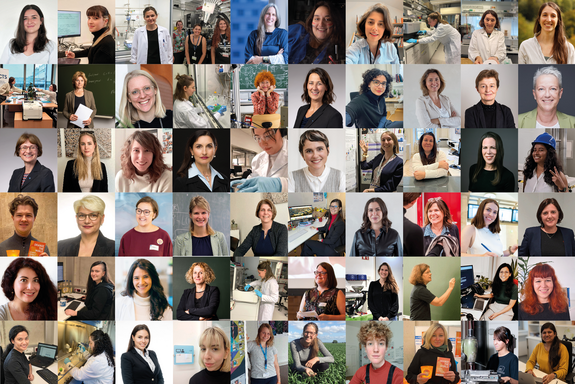Over 60 women and non-binary employees of TU Wien took part in the "We are "Women & Non-Binary People in Science" campaign on the occasion of the "International Day of Women and Girls in Science" on 11 February and sent their picture for a collage with the many female and non-binary faces of TUW. With this campaign, we would like to highlight the important contribution these people make to TU Wien. Many thanks to everyone who got involved!
Women in Science*
The UN is organising the International Day of Women and Girls in Science to support and promote women's access to and participation in STEM education and research activities. Around this date, TU Wien will present women and non-binary people who work for and in science at TU Wien and thus give technology a female or non-binary side.
Inequality in science and society
Inequality in our society is also reflected in science and universities - for example, women* receive less research funding than their male colleagues and only 12 per cent of members of the national science academies are women. In top fields, only one in five experts is a woman, the careers of women in science last less long than those of men and they are underrepresented in scientific journals.
Women in Austria already graduate from university more often than men, but they are still heavily underrepresented in STEM subjects - the subjects in which the technologies of the future are researched and developed. In addition, specialists in these subjects can expect a higher income: The proportion of women for the academic year 2020/21 is 55.8 per cent (Statistics Austria: 02/2023) - in the fields of "Technology" and "Mining Studies", the proportion of women graduating is only 28.9 and 24.6 per cent respectively (academic year 2020/21, Statistics Austria: 02/2023).
A look at the TUW
TU Wien is convinced that the technologies that surround us should be designed by all population groups and for all population groups. This works best if the people involved in their research and development are also diverse.
At TU Wien, the gender ratio of students is around 33 per cent women and 66 per cent men (academic year 2021/22). However, the proportion of women at the various faculties varies greatly. While the proportion of female students at the Faculty of Architecture and Planning and the Faculty of Technical Chemistry is just over 50 per cent and around 44 per cent respectively, the proportion of women at the Faculties of Electrical Engineering and Information Technology or Mechanical Engineering and Management Sciences is only 13-14 per cent.** The proportion of women in professorships at TU Wien is developing positively: within one year - from 2021 to 2022 - it rose by just under three per cent: from 16.3 per cent (2021) to 19 per cent (2022).
While more women than men are employed in the so-called "general staff" at TU Wien (52.1 per cent), women are significantly underrepresented in the "scientific staff" with a share of around 25 per cent. Detailed and comprehensive facts and figures on gender relations at TU Wien are recorded and analysed in the Gender Monitoring published annually by the Gender Competence Department.
At TU Wien, gender equality is enshrined in two documents, including the Women's Promotion Plan and the Gender Equality Plan. One of the most important measures is to sensitise and raise awareness among all TU members. This is promoted through various formats, such as the e-learning courses on "Unconscious Bias" or "Diversity Basics" for TUW employees and students.
If we look at the figures, we can see that we are heading in the right direction. Achieving the goal of a gender-equitable university requires more than these measures. We need to break down old gender stereotypes and bring about a cultural change, especially in those disciplines that still have a strong male connotation. People who do not categorise themselves in binary gender categories are (currently still) largely invisible in the data. Much remains to be done here too. And we are convinced that we all need to make an effort to achieve this.
* In the following, we refer to the situation of women, as no data is yet available for non-binary people.
** All figures from the year 2022
Article by: Ruth Strobl and Edith Wildmann
Sources (partly in German Language):
- Gender Monitoring: Zahlen, Fakten, Analysen X und Gender Monitoring: Zahlen, Fakten, Analysen IX
Bildung - STATISTIK AUSTRIA - Die Informationsmanager bzw. Gender-Statistik BildungUN International Day of Women and Girls in Science - Forbes Magazine
Links:
- Abteilung Genderkompetenz
- Gender in der Lehre
- Geschlecht und Innovation
- Frauenförderungsplan der TU Wien
- Gleichstellungsplan der TU Wien
- UN Women and Girls in Science Day
